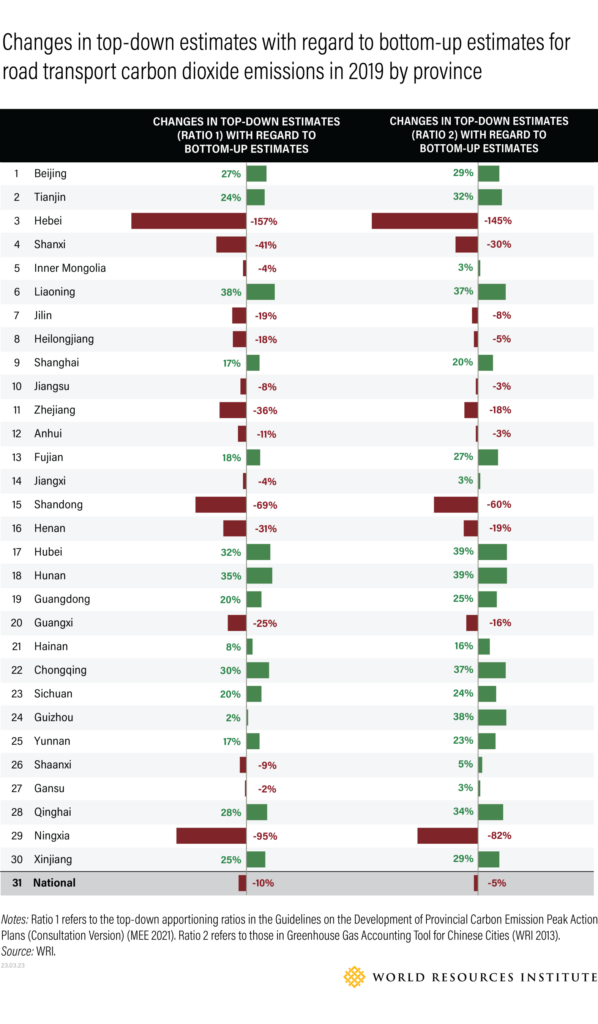
China’s transport CO2 emissions accounted for 11% of the world’s transport greenhouse gas (GHG) emissions, following only the United States (21%), according to data from Climate Watch. And these numbers have been growing rapidly: The average annual growth rate of China’s transport CO2 emissions 2012- 2019 was 4%, the second-fastest growth rate among the 10 countries producing the most transport emissions in 2019, following only India’s 5%.
WRI research shows growth in China’s transport CO2 emissions are even more rapid at the subnational level. In western and central China, the average annual growth rates of transport CO2 emissions during 2012 and 2019 reached 8%-10% and doubled from 2012 to 2019.
To ensure China can meet its target of peaking CO2 emissions before 2030, subnational governments are developing sectoral emissions-reduction targets and emissions-peaking action plans. Like the saying, “we can manage what we measure,” accurately measuring transport emissions is crucial for subnational governments to set emissions-reduction targets, develop peaking action plans and monitor emissions reduction progress over time.
Further, transport emissions inventories are also needed to improve the overall national inventory so China can meet the new United Nations Framework Convention on Climate Change (UNFCC) reporting requirement under the Paris Agreement – the Enhanced Transparency Framework (ETF). ETF requires that starting in 2024, all parties shall report annual national inventories of anthropogenic GHG emissions and removals, as opposed to the current ad hoc inventory reporting practices employed by China.
However, WRI’s new working paper, Toward Credible Transport Carbon Dioxide Emissions Accounting in China, shows that in the absence of comprehensive and reliable statistics and standardized emissions accounting methods, subnational transport carbon emissions estimations are uncertain and inconsistent. As a result, subnational governments face challenges setting transport emissions-reduction targets and tracking their decarbonization progress. To address these challenges, the study provides four recommendations to improve the statistical data collection and emissions accounting methods.
Challenges In Subnational Transport Carbon Emissions Accounting
Based on investigations of existing transport emissions accounting methods and statistical data used by China’s subnational governments, WRI’s study reveals that uncertain and inconsistent subnational transport emissions estimations are attributable to:
1) Incomplete and unreliable fuel consumption statistics.
Globally, there are primarily two methods to estimate transport carbon emissions: the top-down method using fuel sales statistics, and the bottom-up methods using parameters like vehicle stocks and vehicle kilometers travelled (VKTs). The 2006 IPCC Guidelines for National Greenhouse Gas Inventories indicates the top-down method is “more reliable for CO2 estimates.”
However, WRI’s study shows that transport emissions estimated using the top-down method are not as certain as suggested by the IPCC, due to incomplete and unreliable fuel sales statistics. In China, fuel sales statistics are collected from numerous downstream operators of vehicle, air, vessel or locomotive fleets, as opposed to upstream sources like fuel station operators or fuel terminal owners, as is the case in many countries. Due to institutional silos and to save administrative costs, only fuel consumption of large operators is collected in China. Fuel consumption of small operators or individual users, such as private cars and light-duty trucks – which represented 96.5% of China’s vehicle fleet in 2019 – is combined with non-transport sectors.
Although government entities and WRI recommended using apportioning ratios to reclassify a certain percentage of fuel consumption from the non-transport sectors to the transport sector, due to the lack of empirical evidence, ratios proposed by different entities led to uncertainties (up to 12% variations) in top-down estimations. Further, national-level ratios applied to provinces over time, without considering local economic structures and increasing adoption of zero-emission vehicles, also led to questionable subnational emissions estimates. What is worse, fuel consumption reported by large fleet operators was inaccurate. In the absence of a standardized corporate-level emissions accounting guideline, large operators do not distinguish between domestic fuel consumption and international bunker fuel consumption when reporting the fuel consumption data. Further, the reported data was not verified, because of the lack of a monitoring-reporting-verification (MRV) mechanism.
As revealed by WRI research, due to incomplete and unreliable statistics used for the top-down method, most provinces employ both top-down and bottom-up methods to estimate transport CO2 emissions. However, the differences between the top-down and bottom-up emissions estimates are large: After adjusting VKTs to keep the differences in national CO2 emissions estimations using the two methods within ±5%, subnational top-down estimates of road transport emissions in 2019 ranged from 157% lower to 42% higher than the corresponding bottom-up estimates (figure below).
The large differences between the subnational top-down and bottom-up estimates would affect not only policymaking, but also emissions-reduction target setting. For example, using the top-down method, transport emissions declined in Shangdong Province during 2012 and 2019; using the bottom-up method, they demonstrated steady growth.

2) Mismatched emissions mitigation responsibilities caused by allocation of transboundary transport emissions
Subnational transport CO2 emissions (except those from off-road machinery) involve emissions from transboundary trips. How the emissions are attributed to different places or entities is critical to accurately calculating subnational emissions. WRI recommended four allocation methods: fuel sales, induced activity, resident activity and geographic methods.
At present, China does not have an agreed-upon allocation method, and different allocation methods lead to large variations in subnational emissions estimates. And it is crucial to allocate transport emissions to the entities that are best capable of reducing them. In China, transboundary emissions are allocated to the registered locations of large operators using the top-down method. Considering airline operators are registered in only a few Chinese cities and provinces like Beijing, Shanghai and Guangdong Province, using this allocation method would lead to disproportionately large emissions-reduction burdens falling on these places. For example, aviation CO2 emissions alone would comprise 52% of Beijing’s transport CO2 emissions in 2019. However, Beijing cannot single-handedly mitigate aviation emissions because some air travel demands stem from outside of Beijing, and the city has limited jurisdiction over state-owned airlines that serve the whole country. This also deters Beijing from declaring more ambitious emissions-reduction targets.
Pathways to Credible Subnational Transport Carbon Emissions Reporting
To resolve the above challenges, WRI offers four recommendations:
1) Comprehensive fuel sale statistics – especially those from private cars, light-duty trucks and own-account heavy-duty trucks – should be collected at all administrative levels.
To resolve the issue of incomplete transport fuel consumption statistics, China needs to collect the statistics from upstream sources like fuel suppliers, instead of from their downstream customers. This will save the administrative burdens of requiring reporting from the millions of small customers like private car users.
Further, national governments should establish a reporting guideline and MRV mechanism for upstream fuel suppliers, to ensure the data quality of fuel consumption statistics.
2) CO2 emissions from aviation, railways and water navigation should be allocated to the responsible corporations.
Because railway, aviation and water navigation are predominately state-owned enterprises under the national government’s purview, the transboundary emissions from these sectors should be allocated to these state-owned companies like China Railway, as opposed to subnational governments. Compared to subnational governments, the state-owned enterprises have more resources to mitigate emissions. For example, airline operators can take measures where local governments have no discretion, such as scrapping old air fleets, acquiring fuel-efficient/zero-emissions aircrafts, purchasing sustainable aviation fuels and improving operation efficiency to reduce aviation emissions.
National governments should establish corporate emissions accounting guidelines and MRV mechanisms to ensure accurate reporting of transport emissions from large operators. Some guiding principles: the fuel used for international trips should be distinguished from the fuel used for domestic trips; biofuel consumption should be excluded from the total transport fuel consumption; and diesel, electricity and natural gas used for road transport, water navigation and railways should be separately reported.
3) Whenever possible, use standardized bottom-up methods with reliable statistics as a complementary method to estimate subnational transport emissions.
Bottom-up methods are useful not only to verify transport fuel consumption statistics, but also to derive emissions breakdowns and inform transport climate action planning.
National governments should develop guidelines for bottom-up methods, with clear recommendations on emissions scope choices, transboundary emissions allocation method selection, data collection, and quality assurance and quality control procedures.
To ensure the reliability of bottom-up estimations, subnational governments particularly need to fill the data gaps in VKTs and fuel efficiency. For example, without the systematic collection of annual VKT statistics, the current estimates of annual VKTs for heavy-duty trucks using small-size, ad-hoc surveys could range from 35,000 to 182,500 kilometers in China, resulting in considerably large variations in transport emissions, using the bottom-up methods.
4) Administrative safeguards should be put in place.
Carrying out subnational transport emissions accounting is a system project. Therefore, governments at all levels should dedicate financial and institutional resources to support: the development of official transport emissions accounting guidelines; the collection of statistical data to support development of transport emissions inventories; the establishment of dedicated offices and emissions data monitoring platforms; and trainings for relevant staff.
The working paper is a part of the NDC Transport Initiative for Asia that streamlines transport carbon emission accounting in China and supports the subnational governments to reach carbon peaking and carbon neutrality goals. We encourage interested readers to read the full paper for more information.
This post originally appeared on WRI’s Insights.
Lulu Xue is the Urban Mobility Manager of WRI China Sustainable Cities Program.
Daizong Liu is WRI China Sustainable Cities Program Director and China Transport Program Director for WRI.






